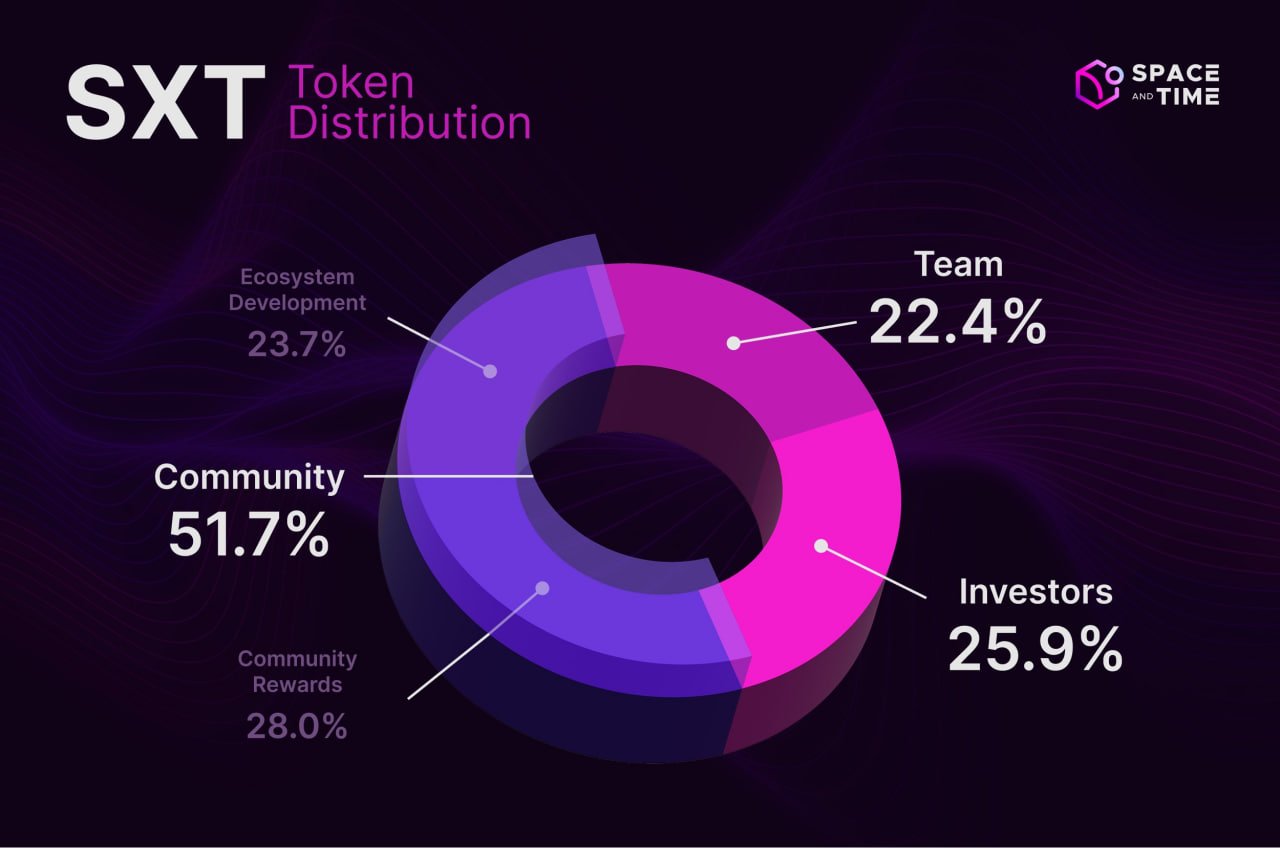The dynamic growth within the cryptocurrency ecosystem means there is always a diverse offering of assets beyond the more established assets like Bitcoin, Ethereum, and the leading altcoins. However, finding such opportunities requires deep research and having your ear on the ground while scouting communities, news outlets, and crypto exchanges to identify emerging opportunities.
The good news is that we can cut the chase for you! Did you know that Binance recently announced enlisting the 69th project on its Launchpool platform, Space and Time (SXT)? So, what is this blockchain for ZK proven data, and what does it have in store for you, a crypto investor?
This guide will explore the intricacies surrounding the Space and Time Web3 digital asset to help you understand how to acquire the SXT Token and how you can participate in the opportunity.
What is Space and Time (SXT)?
Space and Time is a decentralized digital asset platform designed to deliver trustless decentralized data processing to enterprises, SQL for smart contracts, and LLMs. The SXT token uses a sub second ZK coprocessor to scale zero-knowledge proofs on decentralized data warehouses to deliver its mandate of distributing data to different nodes instead of a central location.
The Space and Time project integrates indexed blockchain data from major chains with Offchain datasets to enable developers to create data-driven applications. The platform uses Proof of SQL, a sub second ZK coprocessor that offers enterprise grade security privacy for tamperproof computations at scale. This confirms that query results are not manipulated and can be trusted, especially by leading financial institutions, enterprises, and pre built Web3 APIs. The project uses the proof of time and space consensus mechanism (PoST) to validate transactions.
With the project for blockchain for ZK proven data, users can experience a new level of smart contract operations that integrate on-chain and off-chain data. This will offer the digital world a dynamic economy in which superior verified blockchain data is used on-chain applications offering fresh possibilities.
Key Features of Space and Time
Space and Time deals with several failures of existing Web3 infrastructure through the following features:
- Trustless Data Processing: Using the Proof of SQL protocol, Space and Time can guarantee the integrity of underlying data and the steps to compute answers to ensure they happen accurately and provide cryptographic proof.
- A bridge between On-chain and Off-chain Data: The platform uses smart contracts to access different blockchains and any traditional service database data warehouse for query results.
- Familiar Developer Experience: Using standard SQL by developers makes it easy for them to create data-driven applications without trying to reinvent the wheel by learning new programming languages.
- Scalable Performance: Time and Space introduces low-latency proof generation, ideal for indexing service database data for institutional-level applications. It delivers query results made against million-row tables in less than 3 seconds.
How Does Space and Time Work? Its Network Architecture


Space and Time is designed as a dual-layer network comprising a Validator Layer and a Data Warehouse. The two layers work together to create a trustless blockchain data secured platform that facilitates safe and easy interactivity against on-chain and sensitive private offchain data.
Validator
The Validator layer facilitates communication between the network’s databases and computer clusters within the database warehouse. Database node operators control the network clusters in a permissionless mode besides controlling their connectivity, availability, and usability within the database’s cluster. In addition to verifying the tasks performed by each cluster, the Validator controls the flow of ZK proven data and queries between users and data warehouse clusters. The roles of the Validator within the ecosystem include:
- Routing: The Validator links data driven questions and transactions with the decentralized warehouse network by automatically directing the natural language prompts using data to the appropriate warehouse instance.
- Streaming: It can use the ZK coprocessor and deliver query streams of user data into the network to easily merge with stored data.
- Consensus: It helps maintain data integrity by applying Byzantine fault tolerance at entry and exit points, safeguarding data from errors or malicious activity.
- Query Proofing: Performs query proofing to guarantee tamperproof SQL queries by calculating user inquiry results to generate cryptographic proofs and ZK proven answer next block as integrity proof.
- Table Anchoring: It facilitates a cyclical self-audit process called table anchoring that guarantees proof of storage by updating a Merkle tree every Time fresh data is added to the platform.
Data Warehouse
The data warehouse, on the other hand, operates as the central cog of the platform, running on a decentralized hybrid transactional/analytical processing (HTAP) engine. The warehouse enables trustless, scalable, and efficient performance for all participating data sets. It is made up of different network clusters operating in a trustless manner. The clusters communicate with different warehouse and API servers when prompted by the Validator via the commanding endpoints to deliver query results onchain by performing the following functions:
- Data Saving: They obtain and save data by scaling data warehouse and API servers to infinite ledgers and major chains like Ethereum ZKsync Bitcoin Polygon and others.
- Data Transportation: They move data from one cluster to another.
- Data Storage: They store saved data securely in the warehouse.
- Data Transformation: They clean and aggregate data from multiple sources including others like Ethereum zksync Bitcoin and make them compatible with each other.
- Data Serving: They make the data functional and accessible to the network by creating data warehouse and API.
Proof of SQL™
Space and Time is a decentralized platform that uses the popular SQL data query language to facilitate the building of a user-friendly experience between the client sending the query (Verifier) and the database service (Prover). The primary feature in this case is the concept of commitment that the Verifier guarantees to ensure data integrity by giving the data it sends back a digital fingerprint representing the data in the table.
- Data Ingestion: Once a user submits data for inclusion in the database, it must pass through the Verifier, which generates a commitment with sufficient information to protect it against any form of tampering. Once the commitment is established, the Verifier submits that data for storage and retains the commitment for future reference.
- Query Request: Any time a client or a service requests a query, the Verifier sends the request to the Prover, who analyzes the query, calculates the result, generates proof, and sends the result to the Verifier that maintains the commitment. Finally, the Verifier verifies the results against the request.
Blockchain Indexing
The platform is designed to scout data from any major blockchain indexing service database and decode it by indexing service database data and writing it to relational databases using the following process:
- Generate data from the blockchain: Space and Time uses RPC calls to query blockchain nodes for real-time and historical data.
- Extract data from blockchains: The platform extracts relevant data from any blockchain indexing service database networks and avails it for queries.
- Come to consensus: The network uses the BFT consensus to process service database data warehouse to validate data before loading it to eliminate the need for additional third-party validation.
- Ingest data into the warehouse: After a consensus is reached, the platform inserts processed data into the warehouse, from where it can be queried.
SXT Tokenomics
Space and Time announced the tokenomics and smart contract details for its native asset, the SXT token. According to the company, the total token supply and maximum supply are capped at 5 billion tokens, with an initial circulating supply of 1.4 billion tokens, 28% of the entire token supply.


An additional 125 million SXT tokens are allocated to the SXT Launchpool or 2.5% of the maximum token supply. Moreover, another 25 million tokens will be assigned to marketing activities later when spot trading gets listed, while an additional 50 million SXT tokens will go to marketing services six months after the spot trading listing has taken place. According to the company, the SXT token will be issued on Ethereum’s Mainnet and Binance Smart Chain. The Space and Time crypto token (SXT) is being via Binance Launchpool under the following specifications:
- Total Token Supply: 5,000,000,000 SXT
- Max Token Supply: 5,000,000,000 SXT
- Launchpool Token Rewards (2.5%): 125,000,000 SXT
- Initial Circulating after listing (28%): 1,400,000,000 SXT
- Marketing allocations: 25,000,000 SXT initially + 50,000,000 SXT tokens after six months
Use Cases of Space and Time (SXT)
The Space and Time network architecture is designed to enable smart contracts through the sub-second ZK Coprocessor to query onchain and Offchain data using a zero-knowledge coprocessor. This will work for a variety of use cases, such as the following:
DeFi Enhancements
Developers can build a Web3 credit score system by merging real-world user credit scores with onchain transactions for DeFi platforms. The platform has the potential to facilitate accurate risk assessment within the DeFi lending ecosystem by enabling DeFi platforms to make data-driven decisions, leading to less liquidation.
Moreover, smart contracts can interrogate SXT when processing real-time data to help adjust interest rates and make DeFi platforms more responsive to real-time market conditions. Additionally, SXT will enable smart contracts to access data from multiple blockchains, enhancing cross-chain interoperability.
Web3 Infrastructure
SXT can guarantee data integrity and traceability by providing a secure and verifiable database. By allowing the running of verifiable computations on data, the platform ensures that the results are accurate and verifiable. The verified data can be used to train large language models (LLMs) on provable datasets and ensure that the models are neutral and unbiased.
Gaming and NFTs
Developers can use SXT to build fair and transparent gaming economies, using its verifiable and secure data infrastructure to store and manage gaming data. This can be done by analyzing on-chain and offchain data transactions generated using in-game analytics or community to enable developers to gain more information on in-game activities.
SXT Token
The Space and Time Web3 token (SXT) is an Ethereum-based utility token that serves various functions within the Space and Time data warehouse ecosystem. Among the prominent features of the SXT token are securing the network via staking, facilitating protocol-level payments, incentivizing data providers, and enabling governance participation. The key features of the SXT Token include:
- Network Security and Validation: Validators will use SXT to secure the network and guarantee its integrity. They can stake SXT and earn network fees for their contribution.
- Data Provider Incentives: Space and Time network will use the SXT token to reward users who publish high-quality data, incentivizing the creation and sharing of high-grade datasets.
- Protocol-Level Payments: As the native token of the Time and Space ecosystem, the SXT token will be used to pay for inserting data, querying data, and performing any verifiable computation.
- Governance: Users holding STX tokens can participate in the network’s governance and vote for protocol, upgrades, ecosystem expansion, or feature development.
- Utility for the Stox Ecosystem: STX is also the native currency within the Stox prediction market ecosystem. Users can stake STX by predicting events and earn rewards if their predictions are accurate.
Space and Time (SXT) on Binance Launchpool
Space and Time is the 69th project on the Binance Launchpool platform. The launch allows Binance users to participate in the SXT Launchpool and earn SXT tokens by staking existing crypto assets. Users can lock their BNB, USDC, and FDUSD to receive SXT airdrops over 2 days, with farming slated to begin from 2025-05-06 00:00 (UTC) while trading is set to start at 2025-05-08 13:00 (UTC) by creating a distribution model that allows interested users to acquire tokens without buying them which looks like a win-win situation for the project and the crypto holders.
For more information, check out Space and Time (SXT) Listing Details on Binance.
How to Participate in the SXT Launchpool on Binance
Step 1: Update Your Binance App: You need to update your Binance App to version 2.89.0 or higher to access the latest Launchpool features and ensure a smooth yield farming experience.
Step 2: Prepare Your Eligible Assets: The reward process of the SXT Launchpool currently supports three digital assets for farming, namely:
- BNB (85%) – 106,250,000 SXT
- FDUSD (5%) – 6,250,000 SXT
- USDC (10% – 12,500,000 SXT
Step 3: Log in to the STX Launchpool Page: If you’re using the Binance app, navigate to the “Earn” section or go to the “More” drop-down if you’re using the website. Go to the menu options, select “Launchpool,” and find the Space and Time (SXT) project card.
Step 4: Lock Your Assets: Choose the pool you want to participate in between BNB, FDUSD, or USDC, and enter the number of digital assets you wish to lock in the pool. Click “Lock” to confirm your participation. Users can participate in different pools simultaneously, but they can only lock each token in one pool at a time.
Step 5: Monitor and Claim Rewards: Farming starts on May 6, 2025, at 00:00 (UTC), and earned rewards accumulate hourly. You can claim your rewards anytime by clicking the “Claim” button.
Step 6: Prepare for Trading: Once the farming period ends on May 7, 2025, at 23:59 (UTC), the SXT token will be listed for trading, which opens on Binance on May 8, 2025, at 13:00 (UTC). Initially, trading involves SXT/USDT, SXT/USDC, SXT/BNB, SXT/FDUSD, and SXT/TRY trading pairs.


Final Verdict: Is Space and Time a Good Investment?
The choice by Space and Time network to debut at the Binance Launchpool and its imminent listing on cryptocurrency exchange Binance highlights an important milestone for the project. The move gives the project a chance to experience massive exposure and distribution while giving Binance users the privilege of earning SXT tokens while participating in crypto staking. </span>
Since the farming period is relatively short, users who act fast to stake their assets can earn extra tokens. Whether you’re going to farm or you’ll be waiting for the initial listing, the launch of the Space and Time Web3 token presents an exciting opportunity for every Web3 enthusiast.
Blending the best of a Web3 decentralized data warehouse and the best of on-chain and off-chain data, the launch is bound to transform the way developers and users employ decentralized apps to handle data, offering an exciting opportunity for any investor who believes in the power of Web3 technologies and their related digital tokens.
FAQs
What is the SXT chain?
The SXT Chain is a blockchain network owned by Space and Time for ZK-proven data. The platform operates as a decentralized database that collects data from on-chain and off-chain sources. The platform is designed to secure data using its ZK coprocessor to make it tamperproof.
What is Proof of Space and Time in crypto?
Proof of Space and Time (PoST) is a consensus mechanism in cryptocurrencies that verifies whether network participants have stored a specified amount of data and maintained</span> it onchain for a specific period. The consensus is via “farming,” a process that enables participants to generate a proof of space (plotting) before they can respond to network challenges.
Why invest in Space and Time (SXT)?
<span style=”font-weight: 400;”>Since SXT is a decentralized digital currency that no government or financial institution controls, it becomes a perfect alternative to fiat currency. While investing and trading SXT tokens involves a level of risk, they offer an exciting opportunity for anyone not afraid of charting untested ground for potential profits.
 Bitcoin
Bitcoin  Ethereum
Ethereum  Tether
Tether  XRP
XRP  USDC
USDC  Lido Staked Ether
Lido Staked Ether  TRON
TRON  Dogecoin
Dogecoin  Cardano
Cardano  Figure Heloc
Figure Heloc  WhiteBIT Coin
WhiteBIT Coin  Wrapped stETH
Wrapped stETH  Bitcoin Cash
Bitcoin Cash  Wrapped Bitcoin
Wrapped Bitcoin  USDS
USDS  Chainlink
Chainlink  Wrapped eETH
Wrapped eETH  Binance Bridged USDT (BNB Smart Chain)
Binance Bridged USDT (BNB Smart Chain)  LEO Token
LEO Token  WETH
WETH  Hyperliquid
Hyperliquid  Monero
Monero  Stellar
Stellar  Zcash
Zcash  Coinbase Wrapped BTC
Coinbase Wrapped BTC  Ethena USDe
Ethena USDe  Litecoin
Litecoin  Sui
Sui  Avalanche
Avalanche  Hedera
Hedera  Shiba Inu
Shiba Inu  sUSDS
sUSDS  USDT0
USDT0  Dai
Dai  Mantle
Mantle  Toncoin
Toncoin  World Liberty Financial
World Liberty Financial  PayPal USD
PayPal USD  Cronos
Cronos  Ethena Staked USDe
Ethena Staked USDe  Uniswap
Uniswap  Polkadot
Polkadot  MemeCore
MemeCore  Aave
Aave  Bittensor
Bittensor  USD1
USD1  Canton
Canton  Rain
Rain 


